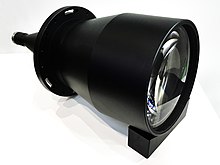Telecentric lens

Telecentric lenses are special optical lenses that are characterized by the fact that the entrance or exit pupil is at infinity. A distinction is made between object-side, image-side and bilateral telecentricity.
Telecentric lenses are mainly used in microscopes and in measurement technology , e.g. B. in optical micrometers . They are also used in projecting systems such as profile projectors or photolithography systems. If the main rays are scaled linearly inwards, they are referred to as pericentria , if they are scaled linearly outwards, they are referred to as entocentricity . Most normal lenses are approximately entocentric. Optimally entocentric lenses are used as distortion-free wide-angle lenses, while pericentric lenses are used for simultaneous object inspection (e.g. of cans) from several sides.
Object-side telecentricity
A beam path telecentric on the object side is used to capture objects without perspective distortion. The entrance pupil is at infinity, so that the main rays in the object space all run parallel to the optical axis. The front lens must therefore be at least as large as the object to be imaged.
Another property of this beam path is that the image scale does not change when the object is axially displaced. The image always appears the same size regardless of the object distance. However, it becomes blurred if the object lies outside the ideal object plane. This property is used in measuring lenses to allow a certain positional tolerance of the test part. The tolerable distance range is determined by the depth of field and is specified in the data sheets. With microscopes, the constant image scale enables convenient focusing.
The easiest way to achieve a beam path telecentric on the object side is to use a single converging lens with an aperture diaphragm in the focal plane on the image side .
Telecentricity on the image side

A beam path that is telecentric on the image side is primarily used to parallelize the beam path . The exit pupil is at infinity, so that the cones of rays all hit the image plane perpendicularly, hence the system is afocal . The simplest structure for this consists of a single converging lens with an aperture diaphragm in the object-side focal plane. In contrast to the purely object-side telecentricity, the tolerable object position is not limited here by the depth of field. You can refocus the image plane without changing the image scale. The simplest structure for this consists of two converging lenses, between which an aperture diaphragm is attached. The distance between a lens and the aperture diaphragm must correspond to the respective focal length . A lens that is telecentric on both sides theoretically has no geometric imaging errors , such as distortion .
In the case of digital camera lenses, telecentric lenses with pinholes are generally not used. There would be little additional benefit compared to low-light (20 mm focal length with f / 4 on 1/3 "sensors), huge (10 kg) and more expensive (€ 20,000) lenses. Nevertheless, the beam paths can be designed in such a way that all light rays are largely perpendicular to the Surface of the image sensor to reduce aberrations when the filter glasses break in front of the sensor.
They are used in applications where they are necessary:
- Partly telecentric lenses and at the same time a large back focus are necessary with three-chip CCD cameras so that the dichroic beam splitter can be used and works sufficiently error-free.
- Telecentric lenses are necessary before H-alpha filters so that non-H-alpha radiation can be blocked by many orders of magnitude. See also H-alpha telescope .
- measuring technology
- Photolithographic manufacturing processes

Telecentricity in lighting
In measurement technology, telecentric lenses (simple design) are sometimes used in lighting.
See also
literature
- Gottfried Schröder: Technical optics. Vogel-Verlag, Würzburg 1977, ISBN 3-8023-0067-X .
- Rainer Schuhmann, Thomas Thöniss: Telecentric systems for optical measurement and testing technology . In: Technical measurement . tape 65 , no. 4 , 1998, ISSN 0171-8096 , p. 131-136 , doi : 10.1524 / teme.1998.65.4.131 .
Web links
- Telecentric lenses. Basics and working principles . Opto engineering.
- Rolf Wartmann: Telecentricity on both sides - a prerequisite for high-precision optical measuring technology . Schneider Kreuznach. (PDF file; 100 KB)
Individual evidence
- ^ Advancing Technology for Amazing Image Quality , getolympus.com, accessed September 13, 2017


